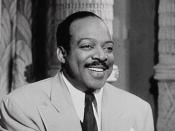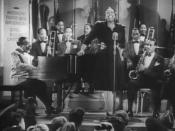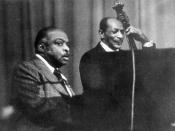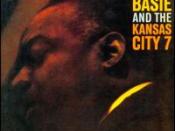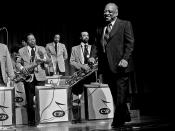Freddie Green was born on March 31, 1911 in Charleston, South Carolina.
All the articles will tell you, Freddie Green is the best in his category; he was a star guitarist. Other musicians will tell you the same. As a jazz musician, Freddie Green could not be touched.
Born Frederick William Green, young "Freddie" as he was called, began playing the banjo before he became a teenager. Sam Walker, a trumpet player and the father of Freddie's friend, taught young Green how to read music. It was Sam Walker who encouraged Freddie to take up the guitar. Walker, an organizer of Charleston's respected Jenkins Orphanage Band, allowed Freddie to perform with the group. An elite group of musicians - two went on to play for pianist Duke Ellington and Count Basie, both famous jazz pianists.
After Freddie's parents died when Freddie was fourteen, he went to live in New York to live with his aunt so he could complete his schooling.
Eventually he began to play in New York Clubs such as the "Black Cat" in Greenwich Village and the "Yeah Man Club" in Harlem. He became the guitarist for the "Night Hawks" who were the house band for the "Black Cat" club. While playing at this club, Freddie was seen by a jazz talent scout who introduced Freddie Green to Count Basie.
Count Basie arrived in New York. He had been in Kansas City and he was debuting at the "Roseland Ballroom." The jazz talent scout, John Hammond, took Count Basie and Benny Goodman to hear Freddie play at the "Black Cat." Basie liked the music of his current guitarist, but after hearing Freddie Green play, he fired Claude Williams and hired Freddie Green.
It was the beginning of a whirlwind life for Freddie Green. In 1937, Green recorded his first album. Green accompanied Basie in the 1928 and 1939 "Spirituals to Swing" concerts where there was a variety of jazz and blues musicians. Green went on to record for Columbia and RCA and he backed up such people as Buddy Tate, Illinois Jacquet, and Emmett Berry - all top musicians in their time. Besides recording with "Count Basie and his Orchestra" during those years, Green also became a part of "Basie and his Kansas City Seven," and "Count Basie and his All-American Rhythm Section." When the big band era was winding down in the late 1940's, several bands fell on hard times. Count Basie was no exception. In 1950, Basie was forced to reduce his orchestra number to a simple handful of players and Freddie Green was essentially out of a job for the first time in more than a decade. However, that situation did not last for long. After being let go by Basie, Freddie showed up with his guitar where Basie was playing and Freddie insisted that he be let back in the band. From that moment on, Basie and Green never parted ways.
By 1952, Basie was back with another big band. They went on to record a reissued album, "Sixteen Men Swinging." Three years later, Freddie Green cut the classic "Mr. Rhythm" under the name "Freddie Green and his Orchestra". The project was a success. A neat blend of rhythmic swing and more modern bebop, it was a hit with countless listeners.
Always liking the sound of an acoustic guitar, Freddie Green was not fond of amplification. He tried amplifiers from time to time, but eventually settled on a Gretsch Eldorado custom guitar without amplification.
He inspired even modern day musicians to stay true to the sound of their acoustic guitars. He also inspired countless musicians to follow their hearts. When asked the secret of his success, Freddie Green humbly replied, "I just play what I know. And that's it." And what an "it" it was! Freddie's heyday was the "Golden Age" of jazz. He played music that combined spirited jazz with danceable rhythms. Freddie Green chose as his voice in music the most effective, yet the most anonymous part of a jazz ensemble - that of a rhythm guitarist.
Ever humble, yet impressively talented, Freddie Green will forever live on in the recordings that were jazz.
"I feel responsible for keeping my part in the structure going, as from the original band. I do what I do. That's enough. It's given me a whole lot of joy, pleasure, good feeling. And some bad feeling which goes with everything - you've got to take the bitter with the sweet. I'm part of it, and I'm doing a job, and that's it. I realize that the public likes the band. And I appreciate it. And I think that's what keeps us going. I go along. After all, you have to live." Freddie Green did live. He lived life to its fullest. On March 1, 1987 Freddie Green played a show in Las Vegas, and then died of a heart attack. He would have had it no other way⦠playing his music and being with his band right up until the last moments of his life.
